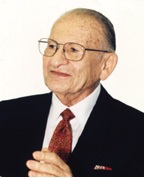About Our Namesake, W. Harry Feinstone

The Johns Hopkins Bloomberg School of Public Health Department of Molecular Microbiology and Immunology is named in honor of W. Harry Feinstone, ScD '39, a retired pharmaceutical researcher and executive from Memphis, Tenn. The renaming in 1996 was meant as an acknowledgment, as Dean Alfred Sommer said at the time, of his “immense contribution to the public's health through his long career in the pharmaceutical industry and his generous support of the School.”
Dr. Feinstone in 2004 established the Alfred and Jill Sommer Chair in Molecular Microbiology and Immunology. His multimillion-dollar gifts to the Campaign for Johns Hopkins have also supported endowments to recruit and support outstanding young scientists within the W. Harry Feinstone Department of Molecular Microbiology and Immunology.
Read W. Harry Feinstone's Letter to the Department
About W. Harry Feinstone
Early Years
W. Harry Feinstone was born in 1913 in Pultusk, Poland. Not long after, his father, a mechanical engineer, emigrated to Brooklyn, New York. With the outbreak of World War I, it was seven years before Harry and his mother could rejoin Mr. Feinstone.
After attending high school in New York City, Harry Feinstone spent a year at New York University, worked for two years as a garment-district salesman, and briefly played semi-professional soccer for a New York team. By 1933, however, he wanted to return to school. Hearing that universities in the southern states were relatively inexpensive, he enrolled at the University of Arkansas.
College
Thirty-six hours after receiving his acceptance letter, Feinstone arrived in Fayetteville, Ark., at 7 a.m., after making connections in St. Louis. He walked to the campus a few blocks away, with $70 in his wallet. “I met a fellow, some man coming my way. He said, 'Hi.' I looked around; that didn't happen in Brooklyn. Somebody else said, 'Good morning,' and pretty soon I got the idea that these people liked me.”
Harry plowed through his courses in three years, graduating in 1936 with a bachelor's degree in biology and chemistry. He wanted to build a career in the pure sciences; his father, however, wanted him to study medicine. Several of his professors at Arkansas sent letters to his father touting a career in science. Harry's zoology professor put it this way:
"Harry has too good a mind to waste in medical work. I am aware that medicine could call for mental activity, but it rarely does, and his mind would become dulled with inactivity."
Graduate School
In 1936 Feinstone traveled to the Johns Hopkins School of Hygiene and Public Health to work as a laboratory assistant in the Department of Bacteriology. His diligence soon caught the attention of School of Medicine professor Perrin H. Long, who invited the ardent student to help him with his pioneering research into the treatment of certain types of infectious diseases. “The next three years were like a dream,” Feinstone recalled.
"While I was working in Dr. Long’s lab, I was chosen to get involved in sulfa drug development during the early days of the research. It was such an important time. At that point, sulfa drugs were emerging as the first chemical substance that had any real effect on infectious diseases. It was a great improvement over arsenic, mercury, and silver compounds, which were ineffective in trials and proved to be tissue-destroying nostrums."
A Career in Pharmaceuticals
Dr. Feinstone graduated from the School of Public Health in 1939 with a ScD in medical sciences, and within weeks was hired by American Cyanamid to direct its division of biological chemotherapy. He was to establish a new research program to continue the work he had begun at Hopkins. Over the next five years, he developed many sulfa drugs—hailed as the first “miracle drugs” of the twentieth century—that are still in use today.
From 1947 to 1958, he was a consultant in product and drug development for several companies. Warner-Lambert, for instance, marketed one of his products, an antihistamine called Anahist, the first over-the-counter cold remedy. In all, Dr. Feinstone worked for some 30 companies, receiving royalties whenever his products were made and sold.
“They would start selling, and a month or two later I would get a check for $24.73, and the next month for $85, and the next month for $300,” he remembered.
His clients included Schering-Plough, where Dr. Feinstone remained until 1976, when he retired as vice president for research and development. His contributions helped make the company one of the world's largest manufacturers of cosmetics and over-the-counter drugs.
Academia
Soon after his retirement from Plough, the University of Memphis invited Dr. Feinstone to start a second career as that university’s first Distinguished Research Professor. He worked at the university until 1993. Interacting with graduate students at Memphis made him aware, he said, “of the importance of attracting younger, eager faculty by providing support for their research”—a philosophy that inspired many of his philanthropic efforts.
Retirement
Dr. Feinstone spent his final years tending to family—he had six grandchildren and six great-grandchildren—and personal business, reading and keeping up with developments at the University of Memphis.
